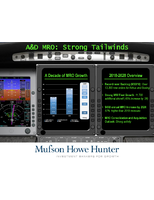Microwave Analog Signal Generators feature low phase noise.
Press Release Summary:
Featuring 2 RU design, Model N5183B MXG features phase noise of less than -124 dBc/Hz and -75 dBc spurious, enabling module- and system-level testing up to 40 GHz. Unit also accelerates calibration of complex systems with switching speed of less than 600 µs. Model N5173B EXG, combining output power of +20 dBm at 20 GHz with low harmonics of less than -55 dBc, is suited for characterization of broadband microwave components such as filters and amplifiers.
Original Press Release:
Agilent Technologies Introduces Microwave Analog Signal Generators with Industry-Leading Phase Noise, Power and Speed
SANTA CLARA, Calif., – Agilent Technologies Inc. (NYSE: A) today expanded its range of signal generators with two new models that provide unmatched performance in phase noise, output power and frequency-switching speed. Complementing Agilent’s flagship E8267D vector PSG and E8257D analog PSG, the new N5183B MXG and N5173B EXG microwave analog signal generators provide important alternatives in size, speed and cost.
“Agilent microwave signal generators are an essential part of today’s most advanced measurement systems,” said Andy Botka, vice president and general manager of Agilent’s Microwave and Communications Division. “They reliably provide the signal purity, output power and modulation developers need to keep pushing the envelope in radar, electronic-warfare and satellite-communications applications.”
The pure and precise N5183B MXG analog is an alternative to the high-performance PSG. The MXG offers accuracy, efficiency and near-PSG performance in just two rack units. Its best-in-class phase noise of less than -124 dBc/Hz (at 10 GHz, 10 kHz offset) and -75 dBc spurious enables module- and system-level testing up to 40 GHz. It also accelerates the calibration of complex systems with best-in-class switching speed of less than 600 µs.
The N5173B EXG analog is a cost-effective choice when system creators need to balance budget and performance. Offering the best combination of output power (+20 dBm at 20 GHz) and low harmonics (<-55 dBc), the EXG is well-suited to the characterization of broadband microwave components such as filters and amplifiers. With low-cost coverage to 40 GHz, it also supports continuous-wave (CW) blocking for receiver testing or basic local-oscillator upconversion for point-to-point microwave backhaul links.
To reduce cost of ownership, the MXG and EXG signal generators are designed for reliability and fast, easy calibration, service and repair. The recommended three-year calibration cycle and self-maintenance strategy help reduce support costs and increase instrument uptime.
The PSG continues to set the standard for performance and is the industry’s most trusted microwave signal generator, with thousands of units deployed in hundreds of programs around the world. It can produce pure CW tones up to 70 GHz; signals with 1 W (+30 dBm) of power; complex, vector-modulated signals with 2-GHz bandwidth up to 44 GHz; and more. With extremely low phase noise of less than -126 dBc/Hz (10 GHz, 10 kHz offset), the PSG can serve as a reference source in metrology labs.
U.S. Pricing and Availability
The new MXG and EXG models are available now worldwide. List prices are as follows:
-- N5183B MXG microwave analog signal generator, from $23,000.
-- N5173B EXG microwave analog signal generator, from $18,720.
List prices for the PSG are as follows:
-- E8267D PSG microwave vector signal generator, from $83,845.
-- E8257D PSG microwave analog signal generator, from $29,469.
For more information, go to www.agilent.com/find/microwaveSigGens. Product photographs can be downloaded from www.agilent.com/find/MW_SG_images. Â A short video overview of Agilent’s expanded portfolio of microwave signal generators is available on YouTube.
About Agilent Technologies
Agilent Technologies Inc. (NYSE: A) is the world’s premier measurement company and a technology leader in chemical analysis, life sciences, diagnostics, electronics and communications. The company’s 20,600 employees serve customers in more than 100 countries. Agilent had revenues of $6.8 billion in fiscal 2013. Information about Agilent is available at www.agilent.com.
On Sept. 19, 2013, Agilent announced plans to separate into two publicly traded companies through a tax-free spinoff of its electronic measurement company. The separation is expected to be completed in early November 2014.




